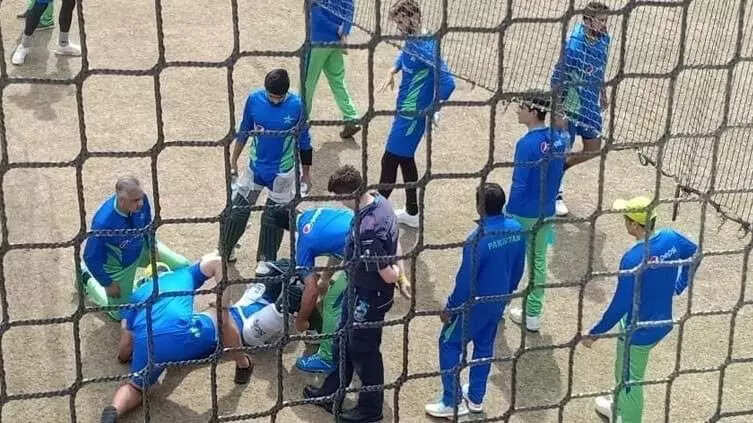[ad_1]

Shan Masood was hit on the head with a stray ball. He was rushed to hospital to check if he had suffered concussion or internal bleeding. Fortunately all he had suffered was superficial bruising.
Photo : Twitter
Friday 21 October was consumed by news of how team Pakistan suffered an injury scare as a stray shot from Mohammad Nawaz struck Shan Masood on the head and left him lying flat on the ground before he was sent to hospital for scans. A distraught Mohammad Nawaz was seen sitting resignedly and worried, resting on his knees as the others gathered around Shan Masood who was lying on the ground. The injured cricketer was rushed to the hospital for a thorough health check-up.
Thankfully, the news that the Pakistani batsman (Shan Masood) has got away with superficial bruising must have come as a relief to the cricketing fraternity which is looking forward to a nail-bitingly exciting game as Pakistan will begin their campaign against arch-rivals India in Melbourne on Sunday.
Here is an explainer of the medical terminologies used above.
What is a bruise?
According to Cleveland Clinic, a bruise, or contusion, is skin discolouration from a skin or tissue injury. This injury damages blood vessels underneath the skin, causing them to leak. The sudden impact on the blood vessels causes the blood to pool under the skin and is seen as patches of black, blue, purple, brown, or yellow discolouration. There’s no external bleeding unless the skin breaks open.
- X-rays to check for bone fractures.
- Blood tests to check for clotting disorders and vitamin deficiencies.
Do bruises need intensive treatment?
Most bruises fade away within two weeks without treatment. More severe bruising and hematomas may last a month or longer.
How is bruising managed or treated?
Doctors advise the following treatments for bruises so as to prevent swelling and relieve pain:
- Rest and elevation of the injured area.
- Application of ice packs for the first 24 to 48 hours after injury (not more than 15 minutes at a time). Repeat throughout the day.
- Apply a heating pad or warm compress to the injured area after two days (several times throughout the day).
- Over-the-counter (OTC) pain medication. Only your doctor can approve the NSAIDs. Self-medication can be dangerous.
What is a concussion?
According to Mayo Clinic, a concussion is a traumatic brain injury that affects your brain function. Effects are usually temporary but can include headaches and problems with concentration, memory, balance and coordination.
Causes of concussion:
- Traumatic Brain Injury (TBI)
- A blow to the head
- Shaking of the head and upper body violently
The Bottom Line:
Though sometimes one may lose consciousness due to concussion, not everyone does. Mayo Clinic warns that after an incident in which concussion may be a likely outcome, NEVER return to play or vigorous activity while signs or symptoms of a concussion are present.
Experts recommend that an athlete with a suspected concussion not return to activities that are associated with a higher risk of another concussion while still showing concussion symptoms.
Disclaimer: Tips and suggestions mentioned in the article are for general information purposes only and should not be construed as professional medical advice. Always consult your doctor or a dietician before starting any fitness programme or making any changes to your diet.
[ad_2]
Source link


